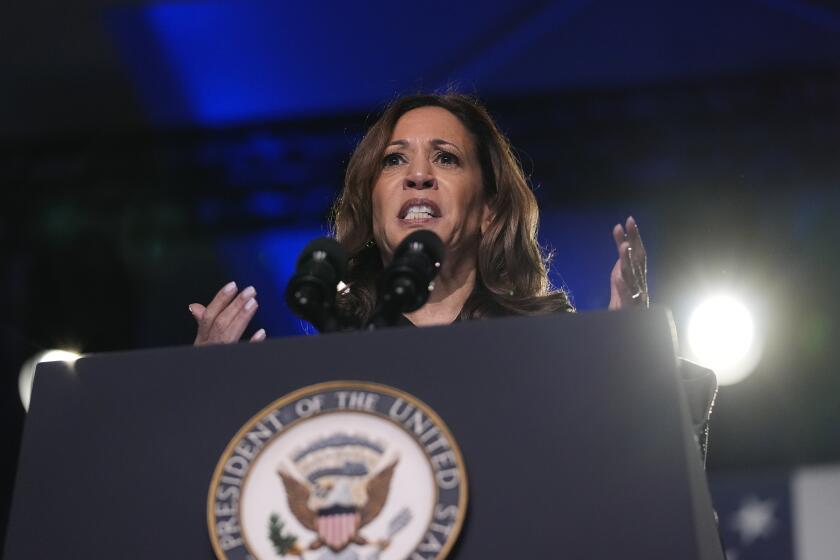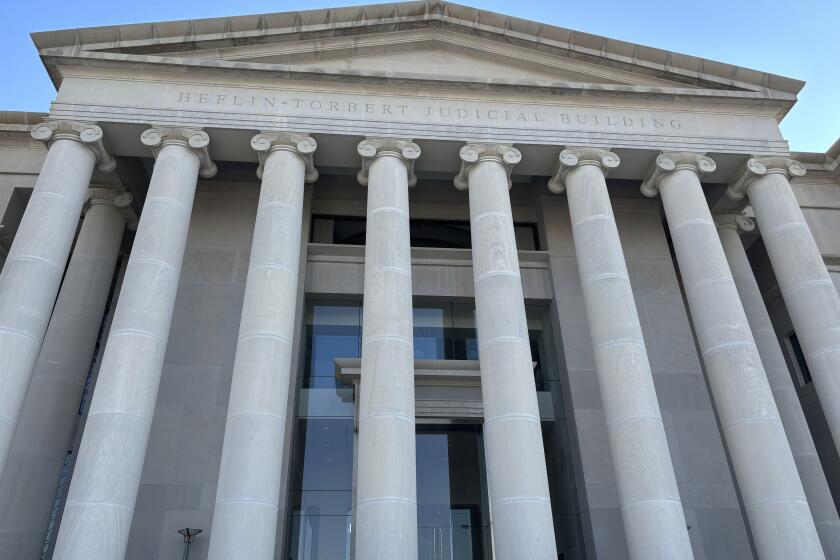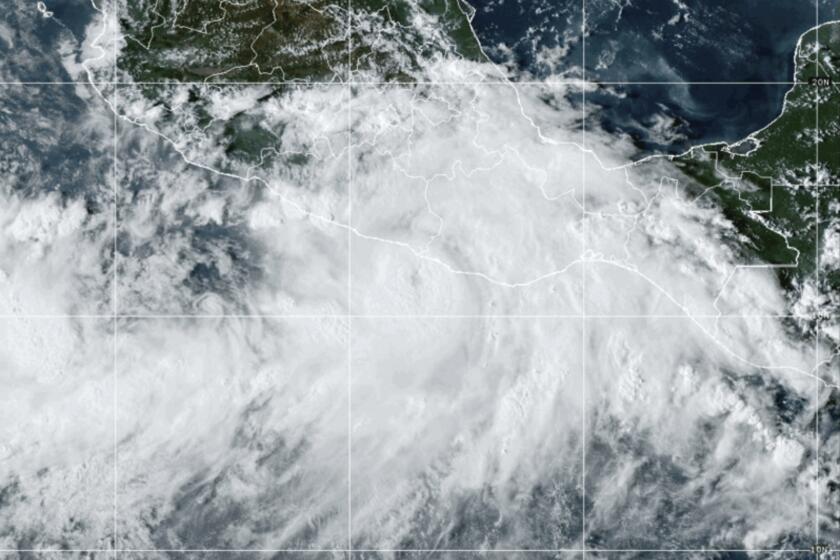U.S. Bombing Spares Much of Kandahar
At first, it seems like the same kind of rubble that lies all over this town of dilapidated earthen brick and crumbling straw. Then there are the signs of ruined lives. A small pair of trousers. A broken dinner plate. A child’s carefully penned exercise book from school.
Here in the Taliban military headquarters, stockpiles of hand grenades, rocket-propelled grenades, camouflage gear and holsters are piled helter-skelter in primitive huts. But there are also the remains of military housing for the families of Taliban fighters. The small complex, and many of those who lived in it, are gone.
“There were about a hundred killed here,” said Abdul Hadi, who strode Wednesday through the mud brick ruins that had been home to Taliban fighters and their wives and children. Not one of the units was left habitable by the dozens of American bombs that struck the large military encampment on the western edge of Kandahar.
“You have to understand, this headquarters is surrounded by civilian houses. About 70% of the people who lived in this village were killed, and more than 100 injured,” Hadi said.
His account was repeated by nearly a dozen other guards at the military complex and by residents of the neighborhoods nearby. They said about 40 families lived in the compound.
“These were the families of our enemy,” said Fatih Mohammed, a security guard for the government of incoming Prime Minister Hamid Karzai. “But you know, the children were not our enemy.”
Ruins Reveal High Degree of Precision
All across this city, which took a hail of American bombs for nearly two months, there is evidence of U.S. firepower--twisted trucks strewn along the road, blown-up tanks, buildings reduced to rubble. For the most part, they reveal an astonishing degree of precision.
The city, headquarters of the Taliban movement, seems to have escaped largely unscathed--except for Taliban government buildings, some electrical and telecommunications facilities, a large variety of military hardware, and suspected offices and housing units of Al Qaeda fighters.
For a city of half a million people that has lost half its population since the bombing started Oct. 7--most having fled to outlying villages or Pakistan--there is far less damage than might be expected. Some phones still work, and there is power in most neighborhoods. According to official estimates, the number of civilian dead is about 60, though reports from witnesses put the figure somewhat higher.
To be sure, there is rubble everywhere--but much of the rubble, Kandahar residents say, comes from two decades of civil war, a Soviet invasion and a government that, at least in the past five years of Taliban rule, was more concerned with the length of beards than the filling of potholes.
To almost no one’s apparent regret, the office of the Ministry for the Promotion of Virtue and Prevention of Vice--which enforced beards, burkas and prayers--was one of the first to go, collapsing in a heap on the edge of Martyrs’ Square, one of Kandahar’s busiest intersections. (The houses of eight Arab families behind the ministry also were leveled.)
A large arms depot west of town contained the twisted remains of a tank, three pickup trucks and a mobile rocket launcher. Much of Taliban leader Mullah Mohammed Omar’s sprawling compound was smashed during attacks that reportedly killed his uncle and son.
The road into town from the Pakistani border is littered with destroyed vehicles and damaged bridges.
At military headquarters, Taliban leaders hid half a dozen tanks from the eyes of bombardiers under a canopy of pine trees. A bomb plowed a crater in the middle of the trees, upending several of them and reportedly killing three people who were driving on a nearby road. But the tanks were undamaged, and Karzai forces on Wednesday began firing them up and returning them to their normal storage area.
“We were standing right here when three people were killed by this bomb. I myself was injured,” said one man, who asked not to be identified. He lifted his pant leg to reveal a shrapnel wound on his calf. “My friend was sitting in his car when the bomb hit it. My friend was killed.”
The small Taliban housing complex must have been miserable even before the bombing. With low-slung roofs and dirt floors, the rooms are dark and chilly. Exposed wiring runs along the walls. Walking through, Hadi finds a small turquoise-colored Koran and presses it to his lips before gently replacing it.
Debris Covers Al Qaeda Training Center Area
“The Taliban families were living here--civilian families,” said Hadi, who works as a security guard for the anti-Taliban forces. “It’s true, this was a training center for Al Qaeda, and too many of them died here. But when will it be over?” he asked. “They say it will be over when they catch Osama bin Laden and Mullah Omar. For two persons, they want to blow up an entire country.”
The military storage bunkers had backpacks, canteens, trousers and jackets piled haphazardly on top of one another. There were stacks of weapons manuals, a sewing machine, an abandoned crutch, an artificial leg.
All were tossed amid bomb debris that in some places was waist-high.
Even Kandahar’s wealthiest neighborhoods were not spared.
Hajiagha Kayyoum, who has become rich by local standards in the import-export business, has reason to regret his decision to rent the houses on either side of his luxurious villa--one of which had recently been the residence of the Pakistani consul--to a large group of Arabs.
When the American bombing campaign started, Kayyoum thought quickly and moved out. In October, a bomb landed squarely on top of Kayyoum’s house at 4:45 one morning, demolishing the other two houses as well. Now the compound is a heap of rubble.
“There were eight dead all together. There is a woman who had three children living there with the Arabs; she might have lived, I don’t know. But I would like to know, what is my fault? I built a house . . . and it has been destroyed,” Kayyoum said. “The Americans should give us some help to reconstruct these houses.”
Down a flight of stairs leading to a basement room below one of the houses, a torn Palestinian head scarf lay on the floor. Young Arab men, probably Al Qaeda fighters, lived in the room, said the watchman, Abdul Haliq. “One day five would come out. The next day, 15. Different. There were many people.”
As he spoke, three men in the black turbans and long beards of the Taliban--hardly seen on the streets of Kandahar since last week’s surrender--glided silently into the compound and stood watching the onlookers. “They are Talibs--real Talibs,” whispered the translator.
What did these observers want, one of the Taliban asked the watchman in Pashto. Why did they go downstairs? “They are American journalists,” the translator said.
“We are up to our nose with Americans,” the Taliban replied. Then he spoke in English. “Due to you people, our country has been destroyed,” he said. Then the three men turned and glided back out of the courtyard, looking for all the world like black ghosts.
More to Read
Sign up for Essential California
The most important California stories and recommendations in your inbox every morning.
You may occasionally receive promotional content from the Los Angeles Times.










